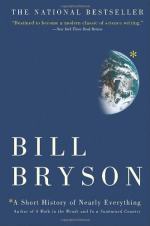
|
| Name: _________________________ | Period: ___________________ |
This test consists of 15 multiple choice questions and 5 short answer questions.
Multiple Choice Questions
1. James Hutton was a geologist who wondered why:
(a) There are no polar bears in Antarctica.
(b) Seashell fossils are found on mountaintops.
(c) The Great Barrier Reef is off the coast of Australia.
(d) Polar ice caps do not melt.
2. In addition to being a seventeenth-century astronomer, Christopher Wren designed:
(a) Eyeglasses.
(b) Cathedrals.
(c) Clothes.
(d) Swords.
3. According to the Caltech physicist Richard Feynman, the most important discovery ever made is what?
(a) Atoms.
(b) Penicillin.
(c) Pasteurization.
(d) Electricity.
4. According to the author, humans today have 625 percent more what in their bloodstream compared to previous generations?
(a) Alcohol.
(b) Pesticides.
(c) Lead.
(d) Chlorofluorocarbons.
5. Max Planck ignored those who urged him to avoid physics and ended up doing groundbreaking work on:
(a) Optics.
(b) Entropy.
(c) Acceleration.
(d) Electromagnetism.
6. When French physicist Henri Becquerel accidentally left a packet of uranium salts on a photographic plate, what happened?
(a) The plate rusted.
(b) The plate became magnetic.
(c) The salt crystals melted into the plate.
(d) An emission from the salts ruined the plate.
7. What followed the last supervolcanic eruption on Earth in the region that is now northern Sumatra?
(a) Twenty years of intense earthquakes.
(b) A reversal of the magnetic poles.
(c) A two-year series of tidal waves.
(d) A six-year volcanic winter.
8. In 1875, why was Max Planck advised against studying physics and urged to study math instead?
(a) Planek knew high-level math but only very basic physics.
(b) A career in math offered greater financial opportunities for him.
(c) It was believed that all the important physics discoveries had already been made.
(d) The government often arrested those who delved in certain branches of physics.
9. Our universe is at least how many light-years wide?
(a) 50 million trillions.
(b) 350 trillion.
(c) 100 billion.
(d) 5 trillion.
10. About how many stars can be seen from Earth using a two-inch telescope?
(a) 30,000.
(b) 3,000.
(c) 3 million.
(d) 300,000.
11. Today, scientists know that radiation in high doses is:
(a) Healthy.
(b) Tolerable.
(c) Toxic.
(d) Safe.
12. What campaign did geologist Clair Patterson take on?
(a) Removing lead additives from gasoline.
(b) Adding fluoride to drinking water.
(c) Fortifying milk with vitamin D.
(d) Removing chlorine from swimming pools.
13. What are so small that the dot on the letter "i" could hold 5 billion of them?
(a) Quarks.
(b) Protons.
(c) Bacteria.
(d) Viruses.
14. What massive bone belonging to a dinosaur was found in New Jersey in 1789?
(a) Hipbone.
(b) Thighbone.
(c) Shoulder blade.
(d) Collarbone.
15. As of July 2001, approximately how many asteroids had been identified?
(a) 2,700.
(b) 29,000,000.
(c) 240.
(d) 26,000.
Short Answer Questions
1. In 1903, who won the Nobel Prize in physics for discovering radioactivity?
2. In 1994, scientists observed as the comet Shoemaker-Levy 9 struck Jupiter. One particular comet fragment struck the planet with a force of six million megatons, which is equivalent to approximately what?
3. Atoms are made up of smaller particles, including:
4. What is found at the very center of the Earth?
5. According to Einstein's theories, what is the nature of space?
|
This section contains 532 words (approx. 2 pages at 300 words per page) |

|




